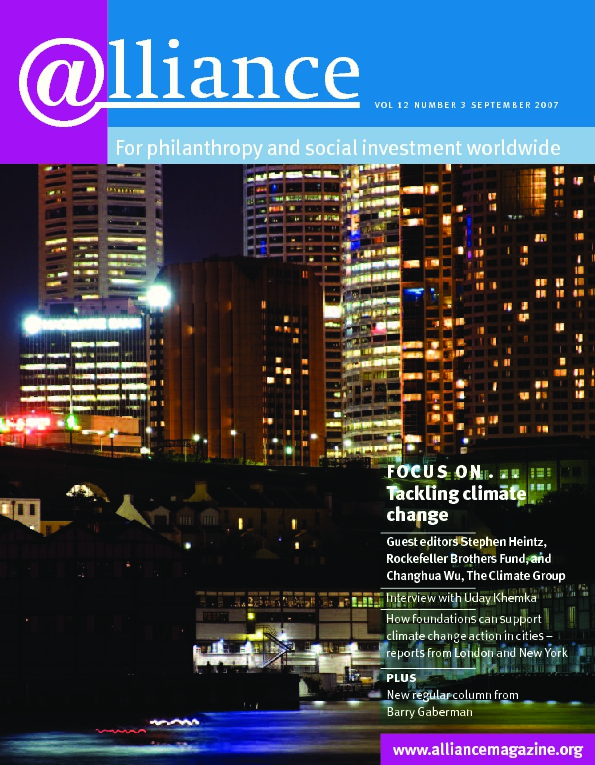The Mayor and I have made tackling climate change our overriding political imperative. Half of humanity lives in cities, and by 2030 two thirds will do so. Already, urban areas consume 75 per cent of the world’s energy and produce around 80 per cent of the greenhouse gas emissions generated by human activity. If we do not reverse this trend, we will fail to save the planet. So there is an extraordinary responsibility for cities to act. While the philanthropic sector has provided key pump-priming support, there is much more it could do to support the actions of cities.
Municipal authorities regulate and manage land use and transport systems and control much of the environmental infrastructure such as water, waste and sewage. They own and operate buildings and vehicle fleets, have huge purchasing power, promote economic development. They have a vital role in forming partnerships with the private sector to engage business leadership and in mobilizing community consensus. Moreover, the density of population and activities of cities mean people can share transport, environmental and social infrastructure. In short, cities have the potential to be very efficient and to act quickly. While leadership from national governments is crucial in tackling emissions, it is city leadership that must spearhead practical action on the ground.
Towards a low carbon London
Our aim is that by 2025 London will be a model sustainable world city. This is a steep challenge as by that time London’s population is expected to have grown by nearly a million, and without action London’s carbon emissions will grow from 44 million to 52 million tonnes per year. We know that solutions to climate change will eventually come through the market driving low carbon technologies, but we can’t afford to wait. To deliver a low carbon London, we began by putting the policy frameworks in place.
In 2004 we published our new strategic London Plan, which is subject to constant review. This sets out our policies for accommodating growth within a more compact, high density city with a vastly improved public transport system. It aims to reduce CO2 by cutting emissions from all sectors.
Our Energy Strategy, also published in 2004, established a target of 30 per cent reduction in CO2 levels by 2025. It is now clear from the science that, to avoid runaway climate change, London will need to cut its emissions by 60 per cent compared with 1990 levels – not by 2050, the UK Government target, but by 2025. This is an ambitious target but it can be done with the policies and programmes already in the pipeline. However, it will need leadership from every sector and additional support, particularly from government, including widespread carbon pricing, investment in research and development of low carbon technologies, and the removal of regulatory barriers to decentralized energy.
To help achieve this target, the Mayor and I recently published the London Climate Change Action Plan. It is radical but achievable. Londoners won’t have to reduce their quality of life to tackle climate change. But we will need to change the way we live.
From policy to implementation
Transport
Transport accounts for 22 per cent of London’s emissions. We have made a good start here by introducing measures such as congestion charging, pricing policies for public transport (free bus travel for under 18s and over 60s) and much higher investment in buses and cycling. This has led to the fastest shift (5 per cent) from car to public transport, walking and cycling in any large conurbation in the world. CO2 emissions are down by 16 per cent within the congestion charge zone and we are greening our fleets with fuel cell and hybrid diesel electric vehicles. We are also halfway through a £10 billion programme of investment in other forms of transport, mainly rail. Our new Low Emissions Zone will be introduced for the whole of London next year.
Buildings
Over 70 per cent of our emissions come from buildings, with our homes producing 38 per cent of London’s total emissions. Our Green Homes Programme includes advice and support to help Londoners reduce these emissions. We are offering cut-price insulation to all Londoners, free of charge to those on benefits. For home owners, we will be rolling out a bespoke deep service model of energy efficiency combined with micro-renewables (such as solar panels). Our Green Organizations Programme focuses on retrofitting existing commercial and public buildings and a badging scheme to change behaviour in workplaces. In new developments, we are introducing requirements for sustainable design and construction, decentralized energy systems and higher targets for renewables.
Energy
Large power stations in distant locations lose about 70 per cent of their primary energy in wasted heat and transmission losses, as much energy as is used by the whole global transport sector. Through our Green Energy Programme, London is pioneering a new way of generating electricity at a decentralized neighbourhood level using combined cooling, heat and power (CCHP) systems. The fuel is initially natural gas but will be replaced with renewable gas from neighbourhood organic and residual waste. Not sending this waste to landfill could provide electricity for 1.2 million homes or heat for 375,000. We also intend to make use of sewage as a source of renewable energy.
Decentralized energy systems can be networked together to form a series of district and neighbourhood schemes. This will not only cut carbon emissions but will offer more security of supply and complement the transmission grid-based systems. This networked local power is as revolutionary as the mobile phone is to the landline.
Philanthropists as champions of the future
The independence of the philanthropic sector means it’s well placed to catalyse change. A good example of this is the London Climate Change Agency, which would not have been set up without philanthropic support.
The Agency was established to reinforce our planning policies and help catalyse the markets for CCHP, renewables and energy services companies. As an innovative form of public-private venture, it is designed to tackle coordination failure and work across the institutional barriers that separate energy, waste, water and transport.
In addition to working on a range of low carbon flagship projects and giving technical advice on major new and existing developments, it has now established and taken a minority stake in the London Energy Services Company (ESCo), which will design, finance, build and operate decentralized energy systems.
The first funding for the Agency came from the Rockefeller Brothers Fund, which in turn attracted substantial philanthropic funding from BP, Legal and General, Sir Robert McAlpine, KPMG and Johnson Matthey, among others, for its five-year start-up phase.
While not all funders are prepared to set up a new delivery vehicle like this, there are actions they could all take to incorporate climate change work into their operations. The sector has a huge role to play in working with the community, voluntary and social enterprise sector. These organizations will find it difficult to go green without capital and revenue funding and capacity building. Funders can ensure that all stakeholders reduce their carbon footprint through energy efficiency, renewables, recycling, low carbon fleets and travel planning. The London-based City Bridge Trust is financing eco-audits and additional grants for some of its beneficiaries, but in the main UK trusts have yet to step up to the challenge.
In addition, support for education and communications campaigns like our Schools Environmental Awards Programme and our DIY Planet Repairs campaign can promote simple lifestyle changes that can make a big difference. So also can the kind of support provided by international NGOs such as the Climate Group and Greenpeace, with their specialist expertise and advocacy skills.
Connecting world cities – the C40
While it is often the smaller cities that lead the way, it is in large cities that huge reductions in emissions can be achieved. That is why the Mayor and I, in October 2005, convened the first climate summit and established the C20 Large Cities Climate Leadership Group, which rapidly became the C40 – 40 of the world’s largest and most polluting cities committed to working collaboratively to cut carbon.
C40 has entered into a partnership with the Clinton Foundation. At the second summit, hosted by Mayor Bloomberg in New York, the Foundation announced the first big procurement initiative – a major energy efficiency retrofitting programme (see p44). Other programmes will be announced over the next year. As they mature, they’ll be opened out to other cities.
However, city and philanthropic leadership will not be enough. For us to achieve the highest reductions, we need national and sub-national governments to put cities back in the driving seat so they can reinvent municipal enterprise in partnership with the philanthropic and private sectors.
Coda
Philanthropy is about legacy. Philanthropists have always been instrumental in creating the social and environmental infrastucture for cities. This same spirit of enterprise is now urgently needed, alongside governments, to redesign cities to tackle climate change.
Donors are ideally placed to protect not only people who live in the areas most vulnerable to climate change today but also future generations everywhere. As Joe Kennedy said, ‘I’d give half my fortune to save the other half.’
Nicky Gavron is Deputy Mayor of London. Email Nicky.Gavron@london.gov.uk
For more information
http://www.london.gov.uk/mayor/environment/climate-change
http://www.london.gov.uk/diy
http://www.c40cities.org
http://www.lcca.co.uk






Comments (0)